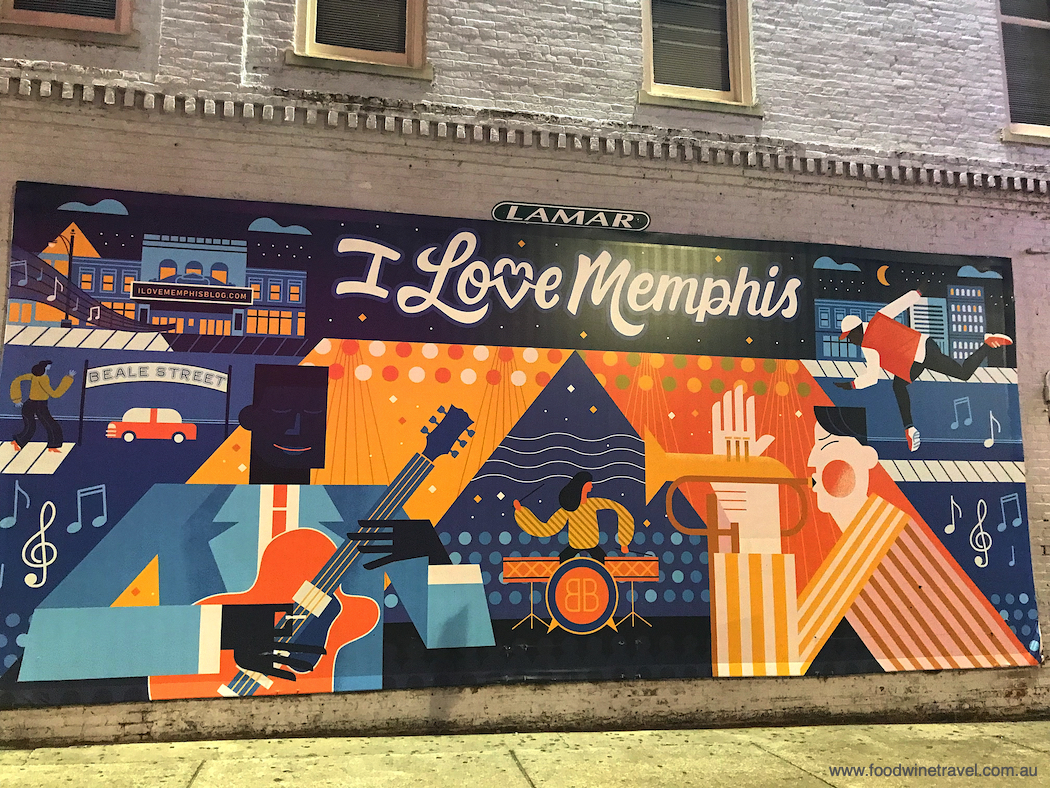
Heading to Memphis, I thought about what I knew about the place and realized it was all bits and pieces and some of it didn’t really make sense. Do they only ever eat BBQ? Why did Martin Luther King Jnr go there anyway? Why is it so close to the states of Mississippi and Arkansas and is there a bridge across the river? Is the music blues, rock ‘n roll, soul or something else? Is it all about Elvis? Why is the place so important in the musical history of America? Why isn’t duck on the menu at the Peabody Hotel? Can Beale Street actually talk? These and many more important questions can only be answered by spending three or four days (at least) there. Even then you may have more questions and more dots to connect.
Elvis
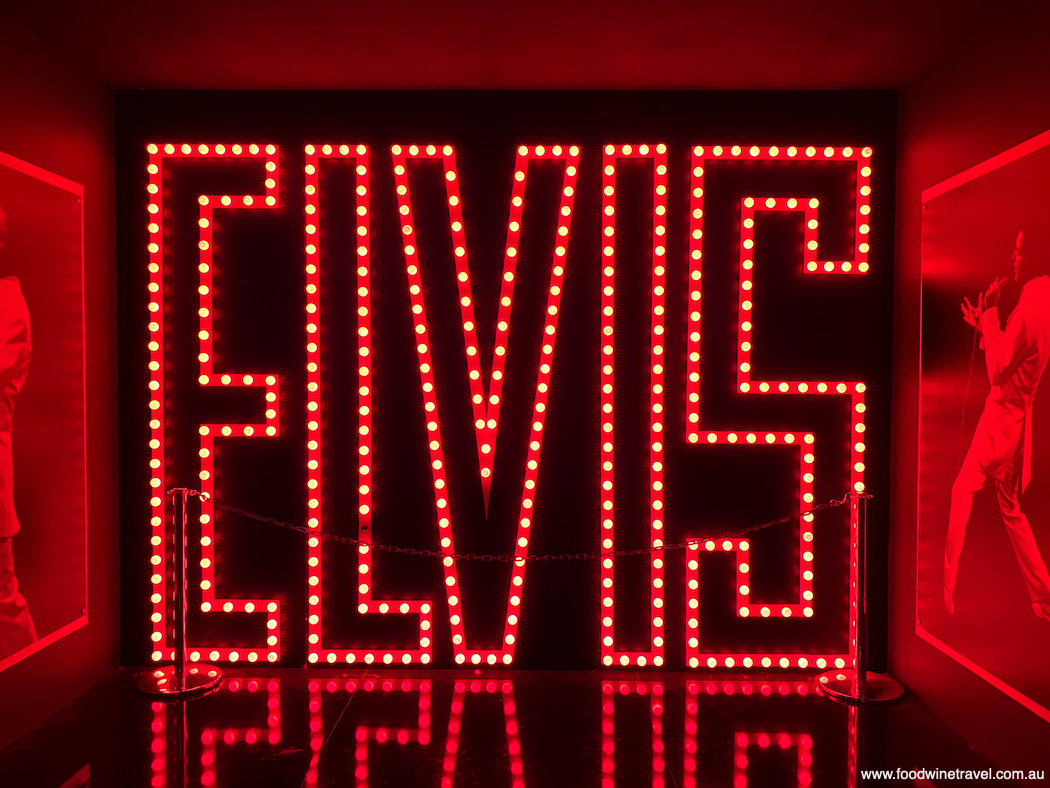
One of the main reasons why many people — and Australians in particular — go to Memphis is to visit Graceland, home of the late Elvis Presley. About half a million people a year wait patiently in single line to file through the house (lower floors only; Elvis’s upstairs bedroom is off-limits). It’s a fascinating house and not as lavish as you might think, remembering that it was 1957 when Elvis bought it and set it up to live in with his parents (and later his wife and daughter).
The longest line is the one filing past his grave and the graves of his daughter and grandson, where most people want to take selfies. Across the road from the house are the museums with his cars, aeroplanes, costumes and other memorabilia, where you could easily spend most of the day.
The night before heading to Memphis, we re-watched Baz Luhrmann’s Elvis movie. The second time around, I found this movie even sadder than when I first watched it, considering how exploited and manipulated Elvis was throughout his career and how he spent his final drug-addicted years alone and unwell.
There is a great exhibition related to the making of the Elvis movie as part of the museums. There is no doubt that the image you’ll most commonly see in Memphis is that of Elvis. There is no end of Elvis memorabilia.
Food
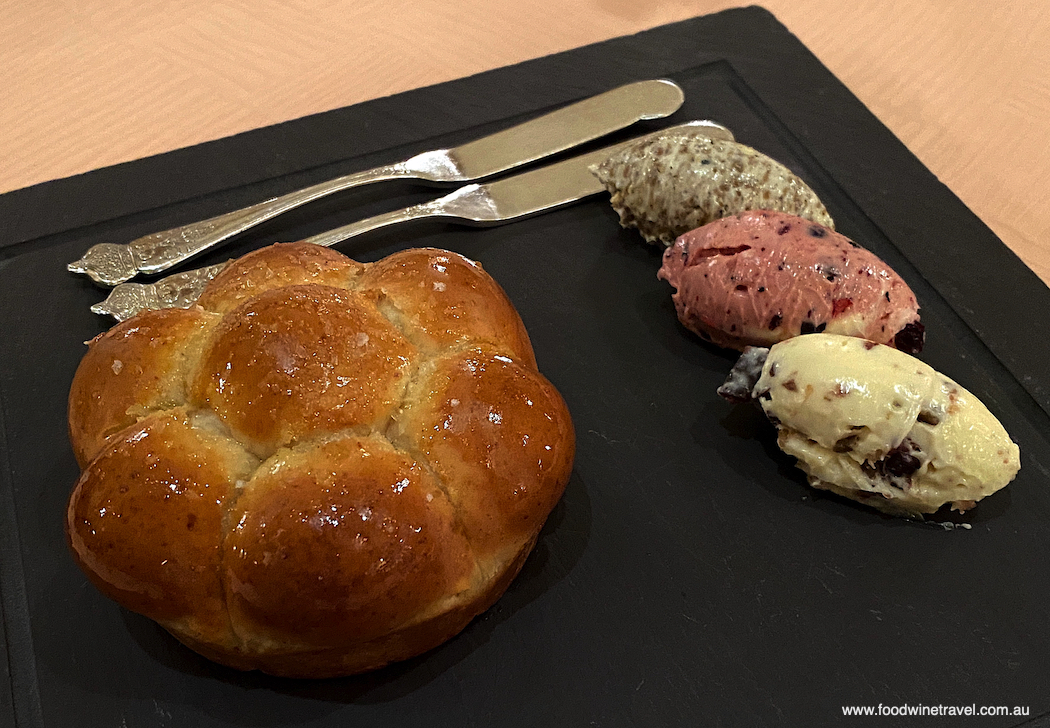
I asked chef de cuisine Keith Clinton at Chez Philippe restaurant in The Peabody Hotel why there was no duck on the menu, especially seeing that it is a French-style restaurant. I think I already knew the answer but he told me that the mallard ducks that parade through the hotel foyer twice a day are a big drawcard and much loved, so people would be upset if duck was on the menu, even though he had some good duck recipes. Despite the lack of duck, the menu is very impressive and I would rate this as one of Tennessee’s best restaurants (if not the best) and even one of the USA’s finest. About 10 minutes’ walk from The Peabody, The Lobbyist is less expensive but also does great food, with an emphasis on seasonal and local produce.
But what about the BBQ I hear you ask? Well, you can do no better than Charlie Vergos’ Rendezvous Restaurant. This family-owned restaurant has been specializing in barbecued ribs for more than 75 years and is a Memphis institution. This is the story of how a Greek migrant took what was then an off-cut, covered it with a rub made from Greek and Cajun spices, barbecued it for a few hours, and created what has become a culinary tradition. The recipe has not changed in all that time, which is why people keep coming back. Their customers have included celebrities and entertainers such as the Rolling Stones and the English Princes, William and Harry. The Rendezvous is an absolute must in Memphis.
But, it’s still all about Elvis and a visit to his favourite diner, the Arcade, is in order. This is an old-style diner reputed to be the oldest restaurant in Memphis and where a number of movies have been filmed. Here you can sit in what was Elvis’s favourite booth and order his favourite meal – a banana and peanut butter grilled sandwich. Having tried this, I really started to question Elvis’s food choices – it’s what may have given him a suspicious mind. I’d suggest there are much better things on the menu at the Arcade Restaurant.
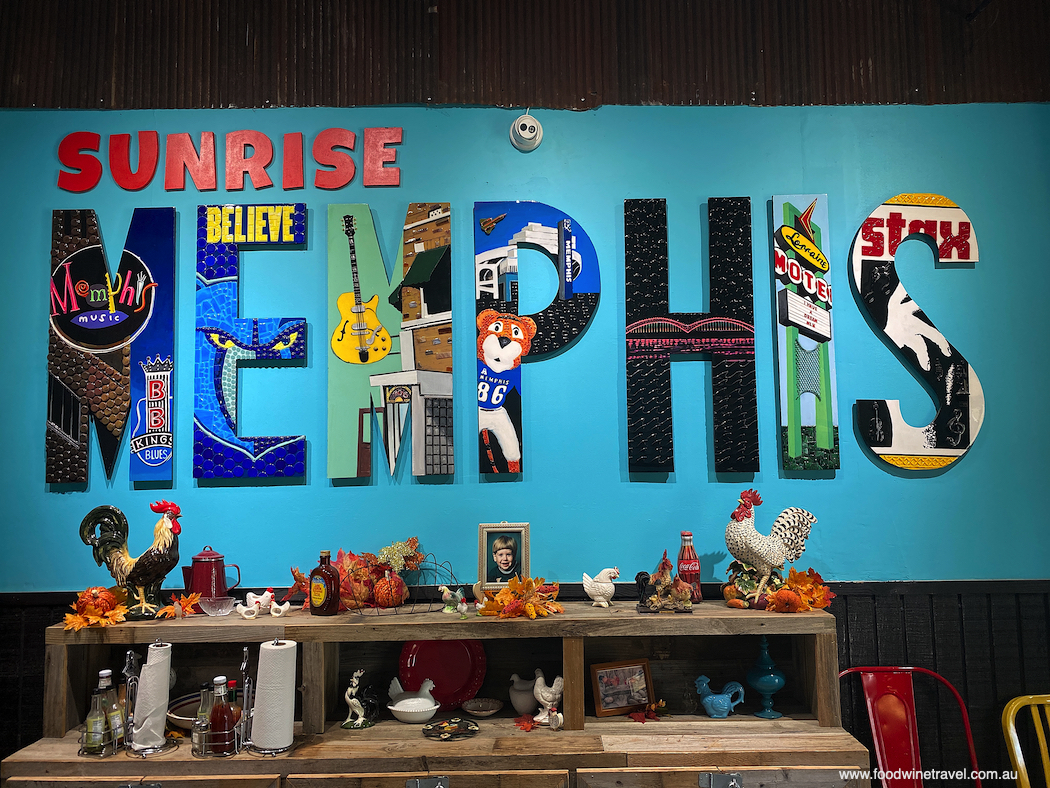
A welcome surprise in Memphis was Sunrise. After encountering many hotel breakfasts in America that involved cardboard and plastic plates and utensils, powdered eggs and strange mass-produced ‘things’, we were delighted with the food at Sunrise. They claim to have the best breakfast in Memphis and that’s no idle boast. Coffees were brought to our table in real cups (not cardboard) by a man who was obviously proud of his creation, declaring: “Hey y’all, this is the best, most frothy cappuccino you’ll get this side of Italy”.
Beale Street
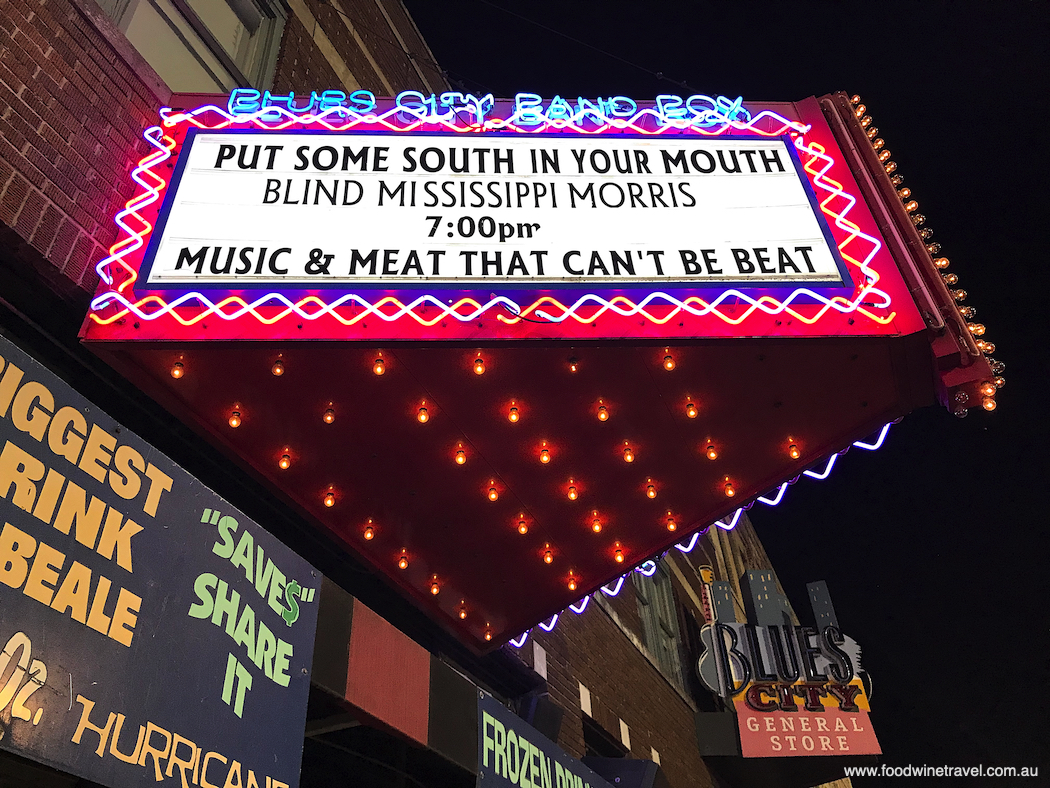
Much of Beale Street was rundown and abandoned in the 1960s and ‘70s but has since become a model of civic restoration and a focus for music tourism. Walking down the street with music pulsating out of every venue, it’s a difficult choice and there’s no end of food options. Outside the Blues Hall Juke Joint I was invited in by a guy who told me that his cousin and sister were about to play and he would probably also join in. He was intrigued by my accent, although he had no idea where it came from. Down on the next corner I was approached by a woman who told me she liked my hat. She was the driver of one of the horse-drawn carriages offering rides to tourists. Most of her customers that day had been Australians.
Further down Beale Street we came to Handy Park where a life-size statue of the legendary W.C. Handy stands. William Christopher Handy is regarded as the father of the blues and these days is often called the grandfather of the blues. One of his first songs, Memphis Blues, sounds more ragtime and maybe that’s not surprising considering the era in which it was written. His later works, such as Beale Street Blues, developed into what we now recognise as Memphis blues.
It was very dark as we approached the Handy statue, and two guys were loitering nearby, looking a bit suspicious. We felt some trepidation and I suddenly realized it was night time, I was wearing sunglasses, it was over 500 miles to Chicago, I was a non-smoker and not driving a car. One of the guys then said, “This is the man! This is him.”
“So you’re devotees?” I asked.
“He was the greatest,” they said. They weren’t Jake and Elwood but they certainly were big blues fans and they encouraged us to visit the W.C. Handy Home Museum the next day.
After these encounters, I realized that Beale Street really could talk. In fact, Beale Street does more than talk, it sings. Every form of music is on offer here. We ended the night at B.B. King’s Blues Club listening to the Ashton Ryker Band and music described as Memphis soul (add that one to your list).
Civil Rights
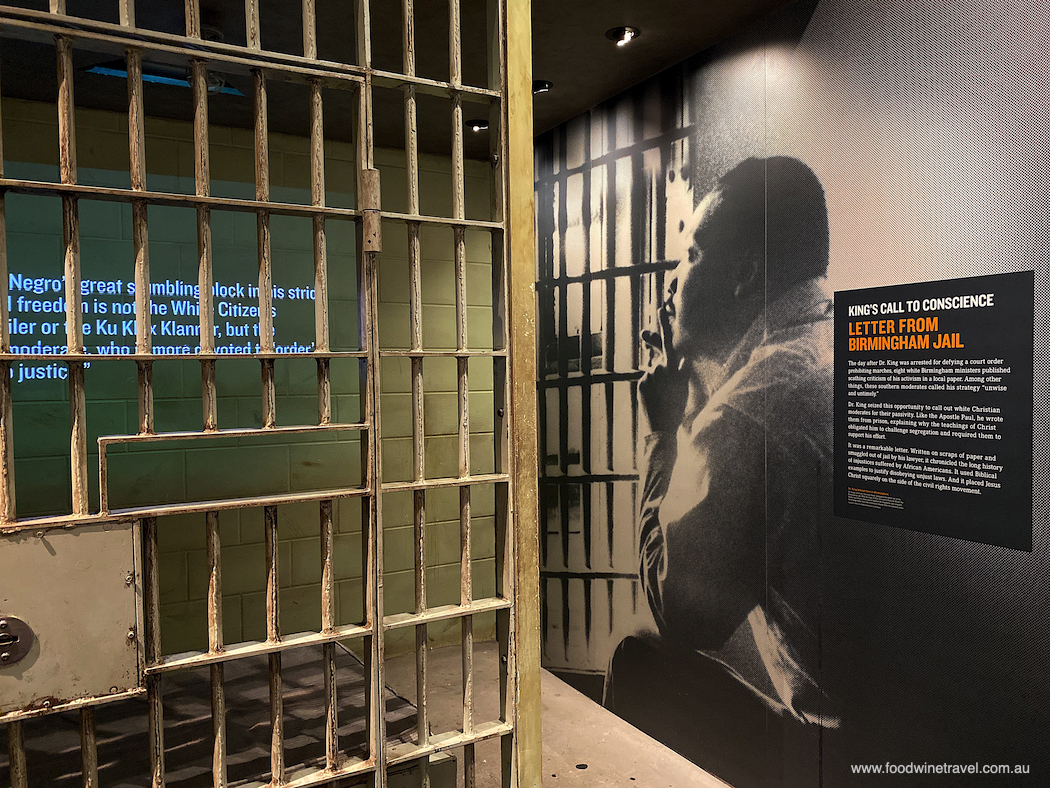
Ironically, the statue of W.C. Handy was erected in 1960 when Memphis was still segregated and entering a decade of intense civil rights activism. Today, the National Civil Rights Museum, established in 1991, incorporates the Lorraine Motel where Dr Martin Luther King Jnr was assassinated on 4 April 1968. It’s a sobering moment to look up at the balcony where this occurred and reflect on what it meant for the civil rights movement and the nation as a whole.
I wondered what Dr King was doing there in the first place. It seems that he often stayed at the Lorraine Motel when he came to Memphis and on this occasion was there in support of the city’s striking sanitary workers. Those workers had gone on strike in February when two of them had been crushed to death in a malfunctioning garbage truck. It was not the first such tragedy and the conditions under which they worked were appalling, with no proper safety regulations and extremely low pay. It was at this time that civil rights and workers’ rights were inextricably linked as human rights.
Following King’s murder, the mayor of Memphis, Harry Loeb, who had refused to grant any concessions to the workers and had a history of opposition to civil rights and unionism, declared martial law and called in the State Police and National Guard. Despite this, on 8 April more than 40,000 people marched silently through Memphis in honour of King and calling for Loeb to grant the workers their demands. Loeb was continuing a long history of segregation and unfair treatment of black people in Memphis, institutionalized by a former mayor, E.H. Crump, who had once stacked the police force with Ku Klux Klan members. The workers were eventually granted some concessions and better pay but had to strike again to actually get them.
The Civil Rights Museum depicts the struggle from colonial times to the present and has a special exhibition on Emmett Till, a 14-year-old boy who was kidnapped, tortured and brutally murdered because he whistled at a white woman. It’s very hard to walk out of this exhibition without a tear in your eye.
Stax
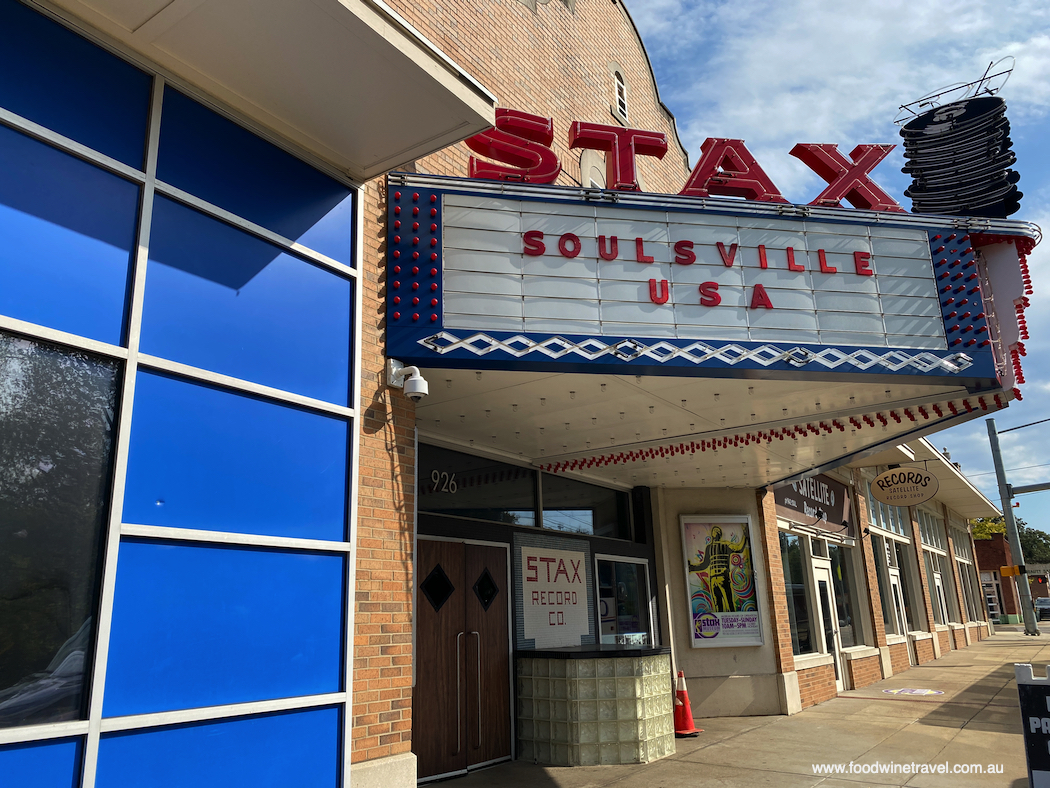
The Stax Museum of American Soul Music is in an area of Memphis called Soulsville and incorporates the original Stax recording studio, repurposed from a movie cinema. Stax was founded in 1957 by Jim Stewart and his sister Estelle Axton who mortgaged her house to fund the project. It was characterized by its community focus, especially through the record shop that Estelle established and a welcoming and inclusive approach. Segregation was not an issue at Stax. It wasn’t long before it had a big list of hit records with artists such as Otis Redding, Booker T & the MGs, the Stapler Singers, Sam and Dave, Aretha Franklin, Issac Hayes and Ike and Tina Turner, to name just a few.
What developed was what was called the ‘Stax Sound’, sometimes called the ‘Memphis Sound’, a kind of combination of blues, rhythm and blues, and soul. It culminated in a massively successful tour by Stax artists in 1967 in Europe where skin colour wasn’t such an issue. Stax collapsed financially in the late ‘70s but the legacy has been revived and lives on thanks to the Soulsville Foundation and the local community. This is a ‘must visit’ museum in Memphis with some unique exhibits, including Issac Hayes’ gold-trimmed Cadillac, and starts with a video outlining the whole story.
Sun Studio
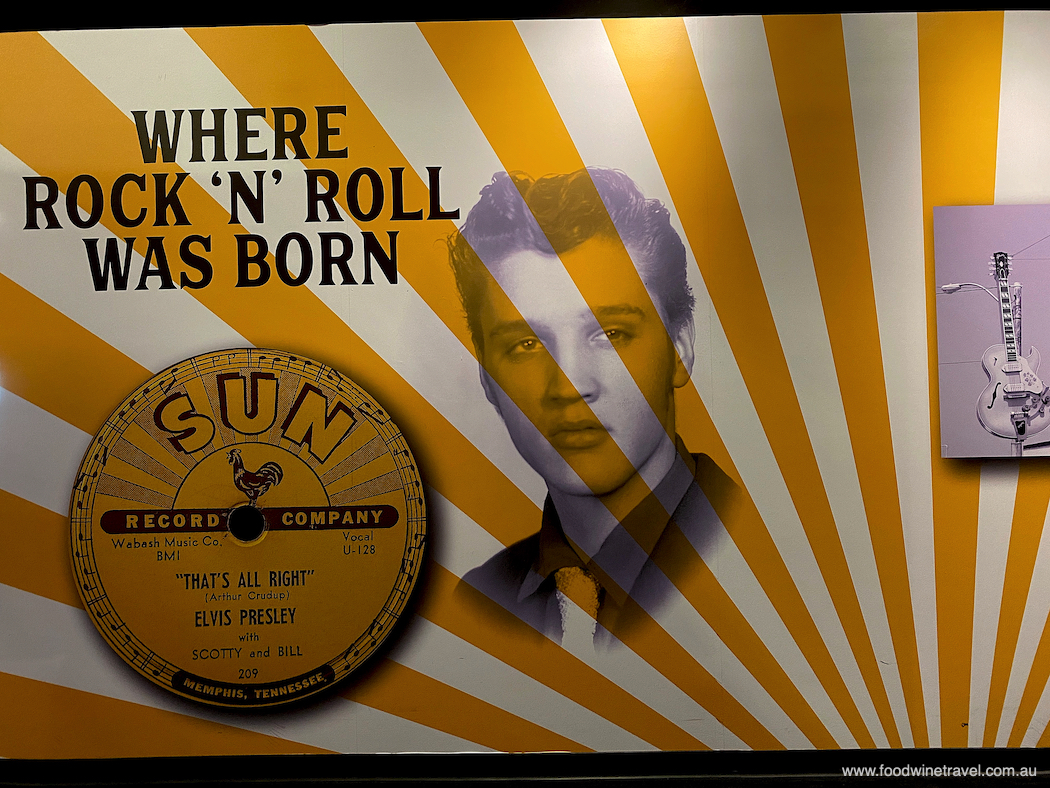
The best thing about the guided tour at Sun Studio is the guide, Josh, himself a musician and an enthusiastic and knowledgeable advocate for the studio. It is fascinating to listen to the first record that Elvis cut, and no, it wasn’t That’s All Right. The recording was a bit too country for Sam Phillips, Sun Records’ founder, who put Elvis ‘on hold’ until he started to rock. It was here in 1951 that the first reputed rock ‘n roll record, Rocket 88, was cut. The sound was due to a patched-up amp that was damaged on the way to the studio. It features Ike Turner on piano. But was it really rock ‘n’ roll? Years later, Ike said he thought it was more R &B but also said that it was what started rock ‘n’ roll. The song is about the Oldsmobile Rocket 88 car and typifies the macho fascination with cars as a symbol of sexual prowess.
Dominating the studio is a large photo taken in December 1956, showing Elvis at the keyboard with Jerry Lee Lewis, Carl Perkins and Johnny Cash surrounding him. The photo was taken by a journalist on the local paper who dubbed them the Million Dollar Quartet. Apparently, they were there for a long time chatting and jamming, although supposedly Johnny Cash didn’t hang around as long as the others. The Million Dollar Quartet is now part of rock ‘n roll folklore and there’s even been a musical about the get together made with the same name.
It’s not surprising that there was a connection between the four musicians considering they all had similar backgrounds. They all came from poor white sharecropping-type families and would have had similar experiences growing up. I would also suggest that the musical tradition they shared at the time was basically Rockabilly. Carl Perkins was of course hailed as the king of Rockabilly and most of Jerry Lee Lewis’s songs, then and later, fell into this category. Johnny Cash was a bit more country but rockabilly was really a combination of rock and hillbilly music (otherwise known as country). Elvis started with country before rock and pop.
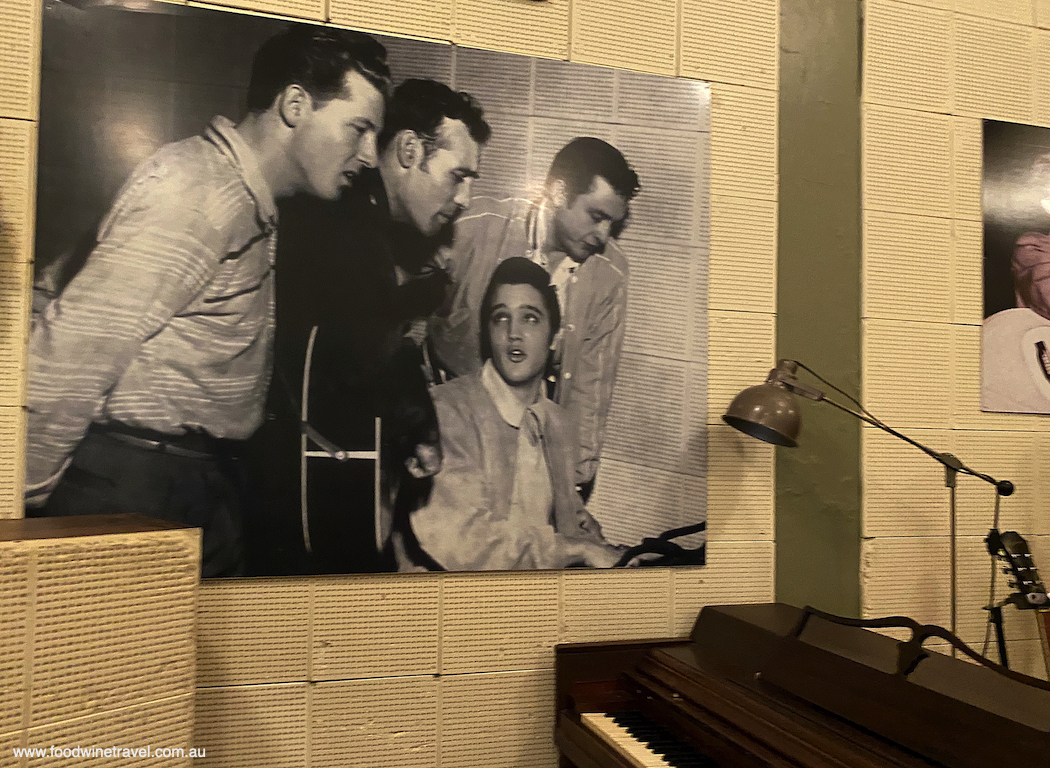
I’m not sure what they talked about but can very well speculate that the jamming and discussion may have led to some iconic songs from each of them. I’d suggest the conversation may have gone something like this:
Elvis: “The warden at the county jail invited me to give a concert there with the prison band. Those jailbirds had the place jumping. You should have heard them sing.”
Jerry Lee: “Wow! They weren’t faking. Sounds like a lot of shaking going on there”.
Johnny: “I once did a stint in Fulsom prison. Time dragged so much and some music would have brought some sunshine.”
Carl: “I don’t know what you did to end up in the can, J R, and I don’t care. What I’m more worried about is the fact that I bought some really cool new shoes today. They’re blue suede and you’re actually standing on them at the moment”.
I’m sure you can see what great songs may have come out of this gathering. We can only speculate what other great music we may have had if they had continued getting together. This could only happen in Memphis where music genres intersect and mutate.
*******
Memphis is the heart of the Mississippi Delta and its centrality has made it an agricultural, economic and cultural hub. It has a rich and often troubled history. It’s regarded as the home of the blues and the birthplace of rock ’n’ roll. It is in fact where a number of forms of music have connected and developed, which is why it has such a central place in the history of American music. In one way it’s all about the music, but in many other ways it’s a lot more than the music. It’s the story of the Civil Rights Movement, the story of migration, and the story of culinary traditions. It’s where all the dots join up and things happen.
For more information about Memphis, visit www.memphistravel.com
If you enjoyed this story, you might also enjoy our post on The Top 7 Things To Do In Memphis.
Disclaimer: Christine and Maurie were guests of The Peabody Hotel and assisted by Memphis Travel in visiting the attractions featured.




Memphis is now on my list of places to visit someday soon!
We can highly recommend it!